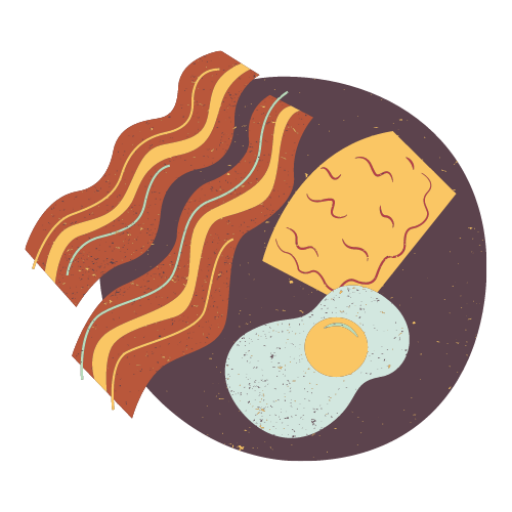Starting your day with a delicious and nutritious breakfast can set a positive tone for the hours ahead. For those following a low FODMAP diet or avoiding gluten, finding suitable morning meals can sometimes be challenging. This article presents 15 breakfast recipes that are naturally low in FODMAPs and free from gluten, offering a variety of tasty options to kickstart your day.
These recipes cater to individuals with sensitive digestive systems or those seeking to reduce their intake of certain carbohydrates. From savory egg dishes to sweet fruit-based parfaits, the following breakfast ideas provide a range of flavors and textures to satisfy different preferences while adhering to low FODMAP and gluten-free guidelines.
1) Poached Eggs with Spinach

Poached eggs with spinach is a delicious and nutritious low-FODMAP breakfast option. This dish combines protein-rich eggs with iron-packed spinach for a satisfying start to the day.
To prepare, gently poach eggs in simmering water until the whites are set but the yolks remain runny. Meanwhile, sauté fresh spinach leaves in a pan with a small amount of olive oil until wilted.
Serve the poached eggs atop a bed of the sautéed spinach. For added flavor, sprinkle with salt, pepper, and a dash of paprika. This simple combination provides a good balance of nutrients without triggering digestive discomfort.
For those following a gluten-free diet, this recipe is naturally compliant. It’s also versatile – try adding other low-FODMAP vegetables like cherry tomatoes or bell peppers to increase variety and nutritional value.
This breakfast is not only easy to prepare but also offers customization options. Adjust the cooking time of the eggs to personal preference, whether that’s a fully set or slightly runny yolk.
2) Quinoa Porridge with Almond Milk

Quinoa porridge with almond milk offers a nutritious and delicious low-FODMAP breakfast option. This gluten-free alternative to traditional oatmeal provides a protein-rich start to the day.
To prepare, combine quinoa flakes with almond milk in a pot. Bring the mixture to a boil, then reduce heat and simmer for about 15 minutes, stirring occasionally. The result is a creamy, comforting porridge.
For added flavor, consider incorporating cinnamon or a small amount of sugar. Top with low-FODMAP fruits like strawberries or blueberries for extra nutrients and taste.
This versatile dish can be customized to suit individual preferences. Some may opt for a thicker consistency by using less liquid, while others might prefer a more soup-like texture.
Quinoa porridge with almond milk is not only easy to make but also highly nutritious. It provides essential amino acids, fiber, and various vitamins and minerals, making it an excellent choice for those following a low-FODMAP diet.
3) Chia Seed Pudding with Blueberries
Chia seed pudding with blueberries is a nutritious and delicious low FODMAP breakfast option. This simple dish combines chia seeds, plant-based milk, and fresh blueberries to create a creamy and satisfying meal.
To prepare the pudding, mix chia seeds with coconut milk or almond milk and a touch of vanilla extract. Allow the mixture to chill in the refrigerator for at least 6 hours or overnight, stirring occasionally to prevent clumping.
The chia seeds absorb the liquid and expand, creating a thick, pudding-like consistency. Top the pudding with fresh blueberries or a homemade blueberry compote for added flavor and antioxidants.
This breakfast is not only low in FODMAPs but also gluten-free and vegan. It provides a good source of fiber, omega-3 fatty acids, and protein, making it a filling and nutritious way to start the day.
Chia seed pudding can be prepared in advance and stored in the refrigerator for 3-4 days, making it an excellent option for meal prepping. Serve it chilled for a refreshing and easy breakfast.
4) Buckwheat Pancakes
Buckwheat pancakes offer a delicious and nutritious gluten-free breakfast option. Despite its name, buckwheat is not related to wheat and contains no gluten, making it suitable for those with celiac disease or gluten sensitivity.
These pancakes are naturally low in FODMAPs, making them a great choice for people following a low FODMAP diet. Buckwheat flour provides a rich, nutty flavor and a tender texture to the pancakes.
To make buckwheat pancakes, combine buckwheat flour with baking powder, salt, and a sweetener of choice. Mix in plant-based milk, such as almond or rice milk, and add a small amount of oil for moisture.
Cook the batter on a hot griddle until bubbles form on the surface, then flip and cook until golden brown. These pancakes can be served with fresh berries, maple syrup, or a dollop of lactose-free yogurt.
Buckwheat pancakes are not only tasty but also nutritious. They are high in fiber and protein, which can help keep you feeling full and satisfied throughout the morning.
5) Coconut Yogurt Parfait

Coconut yogurt parfait offers a delicious low-FODMAP and gluten-free breakfast option. This layered treat combines dairy-free coconut yogurt with low-FODMAP fruits and crunchy toppings.
To create the parfait, start with a base of coconut yogurt in a glass or jar. Add a layer of low-FODMAP fruits such as strawberries or blueberries on top of the yogurt.
Next, sprinkle a layer of gluten-free granola or crushed nuts for added texture. Repeat these layers until the glass is full, typically creating two to three layers of each ingredient.
For extra flavor and nutrition, consider adding chia seeds or a drizzle of maple syrup between layers. The parfait can be prepared in advance and stored in the refrigerator for a quick and easy breakfast.
This versatile dish allows for customization based on personal preferences and available ingredients. It provides a balanced mix of protein, healthy fats, and carbohydrates to start the day.
6) Smoked Salmon on Toasted Gluten-Free Bread
Smoked salmon on toasted gluten-free bread is a delicious and nutritious breakfast option for those following a low FODMAP diet. This simple yet elegant dish combines the rich flavor of smoked salmon with the satisfying crunch of gluten-free toast.
To prepare this meal, start by selecting a high-quality gluten-free bread. Toast the bread to your desired level of crispness. Spread a thin layer of lactose-free cream cheese on the toast for added creaminess.
Top the toast with thinly sliced smoked salmon. For extra flavor, add a sprinkle of fresh dill or a squeeze of lemon juice. These ingredients complement the salmon without introducing FODMAPs.
This breakfast is not only tasty but also provides a good balance of nutrients. Smoked salmon is an excellent source of protein and omega-3 fatty acids, which are beneficial for heart health.
For those who prefer a dairy-free option, replace the cream cheese with mashed avocado. This substitution maintains the creamy texture while adding healthy fats to the meal.
7) Egg and Tomato Frittata
A frittata is an excellent low FODMAP and gluten-free breakfast option. This egg-based dish is versatile and easily customizable to suit individual tastes.
For a delicious egg and tomato frittata, start by whisking together eggs, lactose-free milk, and salt. Heat olive oil in an oven-safe skillet over medium heat.
Add diced cherry tomatoes and spinach to the skillet, cooking until the spinach wilts. Pour the egg mixture over the vegetables and cook until the edges begin to set.
Transfer the skillet to a preheated oven and bake until the frittata is fully cooked and lightly golden on top. This typically takes about 10-15 minutes.
Let the frittata cool for a few minutes before slicing and serving. It pairs well with a side of gluten-free toast or roasted potatoes for a satisfying breakfast.
This protein-rich meal is not only low FODMAP and gluten-free but also provides essential nutrients to start the day. The combination of eggs and tomatoes offers a balance of flavors and textures.
8) Avocado Smoothie Bowl

Avocado smoothie bowls offer a creamy, nutrient-dense breakfast option for those following a low-FODMAP and gluten-free diet. This versatile dish combines the richness of avocado with other FODMAP-friendly ingredients to create a satisfying meal.
The base of the smoothie bowl typically includes ripe avocado, lactose-free milk or a plant-based alternative, and a low-FODMAP sweetener like maple syrup. Blending these ingredients creates a smooth, thick consistency perfect for topping.
Common additions to enhance flavor and nutrition include spinach, banana, and a scoop of low-FODMAP protein powder. These ingredients boost the vitamin and mineral content while maintaining the bowl’s smooth texture.
Toppings play a crucial role in avocado smoothie bowls. Popular choices include sliced strawberries, blueberries, and a sprinkle of chia seeds. These add texture, flavor, and additional nutrients without compromising the low-FODMAP status.
For extra crunch, consider adding gluten-free granola or a handful of chopped nuts like pecans or walnuts. These toppings provide healthy fats and protein, making the smoothie bowl more filling and energizing.
9) Grilled Mushroom Omelette

A grilled mushroom omelette offers a savory and satisfying low-FODMAP breakfast option. This dish combines protein-rich eggs with flavorful mushrooms for a hearty start to the day.
To make this omelette FODMAP-friendly, use oyster mushrooms or canned champignon mushrooms, which are low in FODMAPs. Whisk eggs with a splash of lactose-free milk for added creaminess.
Grill the mushrooms in a non-stick pan with a small amount of olive oil until golden brown. Set them aside and use the same pan to cook the omelette. Pour in the egg mixture and cook until set.
Add the grilled mushrooms to one half of the omelette, along with some chopped chives for extra flavor. Fold the omelette over and serve immediately.
This gluten-free breakfast is not only delicious but also easy on sensitive stomachs. Pair it with a side of low-FODMAP fruits like strawberries or a slice of gluten-free toast for a complete meal.
10) Zucchini Noodles with Lemon Sauce

Zucchini noodles, often called “zoodles,” offer a low FODMAP and gluten-free alternative to traditional pasta. This light and refreshing dish combines spiralized zucchini with a zesty lemon sauce.
To prepare, spiralize fresh zucchini into noodle-like strands. Heat a large skillet over medium heat with a small amount of olive oil. Add minced garlic and sauté briefly until fragrant.
Add the zucchini noodles to the skillet and toss to coat with the garlic-infused oil. Cook for 3-5 minutes until the noodles are slightly softened but still retain some crunch.
For the lemon sauce, combine fresh lemon juice, a touch of lemon zest, and a sprinkle of lemon-pepper seasoning. Pour this mixture over the zucchini noodles and toss to coat evenly.
Garnish with a sprinkle of fresh herbs like basil or parsley for added flavor. This dish can be served warm or chilled, making it versatile for any time of day.
11) Sweet Potato Hash Browns
Sweet potato hash browns offer a delicious and nutritious twist on the classic breakfast side dish. These crispy, golden-brown patties are naturally gluten-free and low in FODMAPs, making them suitable for those with dietary restrictions.
To prepare sweet potato hash browns, start by grating fresh sweet potatoes. Mix the grated sweet potato with a small amount of shallot for flavor, being mindful of FODMAP limits. Season the mixture with salt and pepper to taste.
Heat a skillet over medium heat with a small amount of ghee or avocado oil. Form small patties from the sweet potato mixture and place them in the hot skillet. Cook for 2-3 minutes on each side until crispy and golden.
Sweet potatoes are rich in soluble fiber and easier to digest when cooked thoroughly. They provide a good source of vitamins and minerals, including vitamin A and potassium. When consumed in appropriate portions, sweet potatoes are compatible with a low FODMAP diet.
These hash browns pair well with eggs, bacon, or other breakfast favorites. They can be prepared ahead of time and reheated for quick, convenient meals throughout the week.
12) Apple and Cinnamon Quinoa
Apple and cinnamon quinoa offers a delicious, naturally low FODMAP and gluten-free breakfast option. This dish combines the nutty flavor of quinoa with the sweetness of apples and warmth of cinnamon.
To prepare, rinse quinoa thoroughly and cook it in a mixture of water and apple juice. This infuses the grain with a subtle apple flavor from the start.
While the quinoa cooks, peel and chop an apple into bite-sized pieces. Add the apple chunks to the quinoa during the last few minutes of cooking for a softer texture, or mix them in after for more crunch.
Once the quinoa is cooked, stir in ground cinnamon to taste. For added sweetness, a small amount of maple syrup or stevia can be incorporated.
This breakfast dish can be served warm or chilled. It’s easily customizable with toppings like chopped nuts, seeds, or a splash of almond milk.
Apple and cinnamon quinoa can also be prepared ahead of time as an overnight breakfast. Simply combine cooked quinoa with almond milk, chia seeds, and the other ingredients in a container and refrigerate overnight.
13) Honey and Lemon Overnight Oats

Honey and lemon overnight oats offer a refreshing twist on a classic low FODMAP breakfast. This simple recipe combines gluten-free rolled oats with a zesty lemon flavor and natural sweetness from honey.
To prepare, mix gluten-free oats with lactose-free milk or a plant-based alternative in a jar. Add a squeeze of fresh lemon juice and a drizzle of honey to taste. For extra nutrition, sprinkle in some chia seeds.
Refrigerate the mixture overnight, allowing the oats to absorb the liquid and flavors. In the morning, give the oats a stir and adjust the consistency with additional milk if desired.
Top with low FODMAP fruits like strawberries or blueberries for added freshness. A dollop of lactose-free yogurt can provide extra creaminess and protein.
This make-ahead breakfast is not only convenient but also easily customizable. Experiment with different low FODMAP fruits or a sprinkle of nuts for varied textures and flavors.
14) Tofu Scramble with Bell Peppers

Tofu scramble with bell peppers is a delicious and nutritious low FODMAP breakfast option. This dish mimics the texture and appearance of scrambled eggs while being entirely plant-based.
To prepare, crumble firm tofu into a skillet heated with olive oil. Add diced bell peppers for color and crunch. Season the mixture with turmeric for a golden hue and savory spices like cumin, garlic powder, and black pepper.
Cook the tofu and peppers over medium-high heat, stirring occasionally. The tofu will start to brown slightly, developing a pleasant texture. For added flavor, nutritional yeast can be sprinkled in during cooking.
This protein-rich breakfast is easily customizable. Other low FODMAP vegetables like spinach or cherry tomatoes can be incorporated. Serve the scramble hot, garnished with fresh herbs such as chives or parsley.
Tofu scramble is not only tasty but also quick to prepare, often ready in under 15 minutes. It provides a good source of protein and essential nutrients, making it an ideal start to the day for those following a low FODMAP diet.
15) Pumpkin Seed Granola
Pumpkin seed granola offers a delicious and nutritious low FODMAP breakfast option. This gluten-free treat combines oats, pumpkin seeds, and flax seeds for a crunchy texture and nutty flavor.
The granola is typically sweetened with maple syrup or honey, both of which are low FODMAP in small amounts. Pumpkin puree adds moisture and a subtle autumn taste, while spices like cinnamon and ginger enhance the flavor profile.
To prepare, the dry ingredients are mixed with a blend of coconut oil, maple syrup, and pumpkin puree. The mixture is then spread on a baking sheet and baked until golden brown and crispy.
This granola can be enjoyed on its own as a snack or served with lactose-free yogurt for a complete breakfast. It’s also a great topping for smoothie bowls or fruit salads.
Pumpkin seed granola is not only tasty but also provides essential nutrients. Pumpkin seeds are rich in magnesium, zinc, and omega-3 fatty acids, contributing to its nutritional value.
Understanding Low FODMAP Diets

Low FODMAP diets focus on reducing certain carbohydrates that can trigger digestive issues. This approach aims to alleviate symptoms for those with irritable bowel syndrome and other gastrointestinal disorders.
Key Principles of Low FODMAP
The low FODMAP diet involves temporarily restricting fermentable oligosaccharides, disaccharides, monosaccharides, and polyols. These carbohydrates can be poorly absorbed in the small intestine, leading to digestive discomfort for some individuals.
Common high FODMAP foods to avoid include:
- Wheat, rye, and barley
- Certain fruits like apples and pears
- Some vegetables such as onions and garlic
- Dairy products containing lactose
- Legumes and beans
Low FODMAP alternatives include:
- Gluten-free grains like rice and quinoa
- Berries, citrus fruits, and grapes
- Carrots, spinach, and bell peppers
- Lactose-free dairy or plant-based alternatives
- Nuts and seeds
Benefits of Low FODMAP Diets
Low FODMAP diets can provide significant relief for those with sensitive digestive systems. Many individuals report reduced bloating, gas, and abdominal pain when following this dietary approach.
Key benefits include:
- Improved symptom management for IBS sufferers
- Identification of specific food triggers
- Enhanced quality of life through symptom reduction
- Better understanding of personal dietary needs
It’s important to note that a low FODMAP diet is typically a short-term intervention. After the initial restriction phase, foods are gradually reintroduced to determine individual tolerances.
Working with a registered dietitian can help ensure nutritional adequacy and proper implementation of the diet.
Gluten-Free Cooking Essentials

Mastering gluten-free cooking requires familiarity with alternative ingredients and careful preparation techniques. Proper ingredient selection and handling are crucial for creating delicious, safe meals for those with gluten sensitivities.
Common Gluten-Free Ingredients
Rice flour, almond flour, and cornmeal serve as excellent wheat flour substitutes in many recipes. Xanthan gum often helps improve texture in baked goods. Quinoa, buckwheat, and millet offer nutritious alternatives to traditional grains.
Gluten-free oats provide a hearty breakfast option, but ensure they’re certified gluten-free. Coconut flour adds flavor and fiber to baked treats. Tapioca starch and potato starch can thicken sauces and improve bread texture.
For binding, try eggs, chia seeds, or flaxseed meal. Gluten-free tamari replaces soy sauce in Asian-inspired dishes. Always check labels, as gluten can hide in unexpected places like seasoning blends and broths.
Avoiding Cross-Contamination
Dedicate separate cooking utensils, cutting boards, and toasters for gluten-free use. Clean countertops thoroughly before preparing gluten-free meals. Store gluten-free ingredients in sealed containers to prevent accidental mixing.
Use distinct coloring or labeling for gluten-free tools and storage. Be cautious with shared appliances like food processors or stand mixers. Clean them meticulously or consider separate attachments for gluten-free cooking.
When dining out, communicate clearly with staff about gluten-free needs. Ask about preparation methods and potential cross-contact risks. At home, prepare gluten-free dishes first to minimize contamination chances.
Consider using separate butter dishes, jam jars, and condiment bottles for gluten-free options. This prevents crumb transfer from regular bread or crackers.




